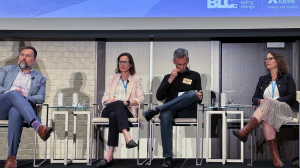The time has come for municipal governments to consider Integrated Project Delivery (IPD) for their major infrastructure projects, delegates attending the recent Association of Municipalities of Ontario (AMO) conference in London, Ont. were told.
Dozens of other municipal projects have been delivered using IPD but it was only recently that the Town of Drayton Valley, Alta. opted for IPD to update its raw water pump station. It was the first municipal infrastructure project ever in North America to use that model.
Aleksi Makila, project director for Chandos Construction on the 2019-2020 job, told delegates during his Aug. 21 presentation that more and more municipal projects are coming in over budget and schedule and it’s time to try a relatively new system like IPD that has proven its value.
“There’s a proven competitive process. There’s a proven procurement process,” said Makila in an interview. “I think people are starved for doing things a different way.
“I think we need to keep up with the growing needs and the infrastructure expansion we have. There’s almost no choice but to look at things differently.”
IPD is usually used for larger projects and the Drayton Valley job, while complex, had a budget of only $4.2 million. ISL did the engineering and Chandos worked with Bird in joint venture on construction. It was felt the tightly co-ordinated IPD process, with its early engagement of all stakeholders, would lead to unconventional solutions, and it did, such as separating mechanical and electrical components that are traditionally in one building.
Case studies on both the Chandos and ISL websites document the numerous other innovations found that led to significant savings for the town.
“The success of Drayton Valley speaks to the functionality of our team,” stated Makila in the case study. “We were productive and on point. We were transparent with one another and the client. We were strong enough to adapt to and overcome challenges.”
The other presenters were Ron Zink, business development director with Corix Utilities, and Ronan Deane, senior project development manager with NAC Constructors.
Deane explained municipal project owners benefit from being integrally involved in major project decisions when they opt for IPD.
“There’s a big feeling that they don’t have any control,” said Deane about traditional procurement.
“With IPD, you’re bringing all the stakeholders into the room, you have designers and constructors working together. When the designers and the constructors come up with something that they think is a good idea, the owner and certain key stakeholders are able to put some influence on it.”
Makila suggested Canadian municipalities have been slow to use IPD for infrastructure projects for several reasons, one of which is that they are still unfamiliar with the model.
During the procurement phase, the municipality can’t find many examples of its use for infrastructure purposes and so they balk.
There may also be complex rules in procurement bylaws that are not part of IPD.
But the results are there for all to see, Makila said: “There’s no denying that you get better projects. So why doesn’t everyone do it? It’s a good question.”
Another water project highlighted at the AMO conference was the Cultus Lake Wastewater Treatment Plant job in the Fraser Valley of British Columbia. The project was just approved by the Cultus Lake council last month, with Chandos among the project partners.
The challenge was that there was a shovel-ready design estimated at $16 million but only $11 million in grant funding available.
It was decided IPD would be used to optimize the design, stretch the project dollars and validate the project without having to try for more funding, the AMO delegates were told.
“The best way to get the best price is when you have all the best minds in the room,” said Deane. “You still have to have the builders’ mindset, you have to be thinking about construction and only construction.
“But you bring your ideas to the table. There’s no gain for you holding on to your good ideas. There’s no gain for the owner to not talk about risks.”
Follow the author on Twitter @DonWall_DCN.







Recent Comments